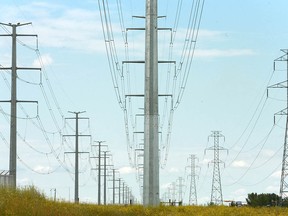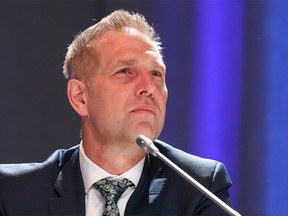
Alberta’s electricity system — and consumers across the province — are in for some changes in the coming months, although it’s unclear just how big the shock might be.
Will the UCP government call for incremental tweaks to the industry or something more revolutionary, such as changing the structure of the provincial power market?
Several reviews within various government departments, commissions and agencies are underway.
The government vows reform is coming.
The throne speech Monday pointed out that electricity prices in the province are too high. Rates have gone from being around the lowest in the country to among the highest.
“Over the coming months, Alberta’s government will work collaboratively with industry and consumers on a package of substantive reforms,” stated the throne speech, delivered by Lt.-Gov. Salma Lakhani.
“These reforms will ensure ample natural gas-generated electricity is brought onto the electricity grid to ensure prices are pushed down and the lights always stay on.
“It will ensure that our electricity market is free from market manipulation and that ratepayers are not left with unaffordable electricity rates under what is now inappropriately termed the ‘regulated rate option.’ ”
Those are weighty pledges, yet it’s still uncertain precisely what steps the government will take.
-
 Alberta throne speech focuses on fight against Ottawa, new tax curbs, but no mention of provincial pension plan
Alberta throne speech focuses on fight against Ottawa, new tax curbs, but no mention of provincial pension plan -
 Varcoe: Stop ‘ragging the puck’ on a federal-provincial deal to kick-start carbon capture projects in Alberta
Varcoe: Stop ‘ragging the puck’ on a federal-provincial deal to kick-start carbon capture projects in Alberta -
 Varcoe: Smith defends Alberta’s pause on renewable projects to clean energy leaders as ‘waiting game’ continues
Varcoe: Smith defends Alberta’s pause on renewable projects to clean energy leaders as ‘waiting game’ continues
Industry players have been expecting an overhaul as much of the province’s electricity system has been placed under a microscope in recent months. This includes the government’s contentious pause on approving new renewable energy projects.
“Along the way, we’ve discovered a number of other things that need to be addressed. The market for electricity is clearly broken,” Premier Danielle Smith told reporters, pointing to the regulated rate option (RRO) on electricity surging to an all-time high earlier this year.
The premier said a package of changes will likely be presented to cabinet at the end of 2023 or early next year. The government will begin to roll them out before the moratorium on approving new renewable projects ends at the end of February.
The electricity industry is in a period of transition, with higher prices and mounting concern by consumers and businesses about their bills. There’s also continuing pressure to decarbonize and electrify more of the economy.
The default regulated rate option for electricity surged to an all-time high of 31.9 cents per kilowatt-hour (kWh) in Calgary during August, although it has since dropped to 18.6 cents for November.
While the pause on new wind and solar developments remains in place, the Alberta Utilities Commission is looking into issues such as land use and end-of-life site reclamation planning within the renewables industry.
Meanwhile, the Alberta Electric System Operator (AESO) has been working on what it has previously called the Market Pathways process, which aims to “develop recommendations on the future power market design in Alberta.”
Under Alberta’s energy-only deregulated market structure, electricity generators are paid for the power produced and sold into the wholesale market.
The previous NDP government wanted to move to a capacity market, under which generators also receive a payment for having firm electricity capacity available on demand, even if it’s not used.
However, that decision was overturned by the UCP government in 2019.
Now, the market structure is being studied.
“This is a really critical period,” Evan Wilson of the Canadian Renewable Energy Association said last week.
“You’ve got decisions that will be made that will impact how we get projects permitted and built and operated in the province. There are going to be decisions that will be made about how we will buy and sell electricity that may or may not be changing.”

Affordability and Utilities Minister Nathan Neudorf said he wrote letters to the AESO and Market Surveillance Administrator (MSA), the province’s electricity market watchdog, about conducting its own examinations that will “feed into our learnings.”
Meanwhile, the province and federal government are locked in a political tussle over Ottawa’s Clean Electricity Regulations, which aim to move provincial power grids to net-zero emissions (or close to it) by 2035.
Smith contends it will lead to blackouts and is pushing for a 2050 timeline, as well as for more natural gas-fired generation to back up intermittent renewable energy.
“We may have to derisk some of these long-term investments in baseload power,” Smith said.
“We’re going to have to make sure that we build baseload power — and what’s available in our market, in a rapid way, is natural gas, with a best effort toward doing carbon capture, utilization and storage.”
And what does that look like?
“Whatever it takes to be able to get natural gas plants built,” the premier said.

Electricity consultant Sheldon Fulton said other electricity expenses, such as rising transmission and distribution costs, and local access fees, need to be studied as these costs have also hit consumers.
“The test has to be, how is this (change) going to benefit that consumer,” he said.
“I am more optimistic than I was six months ago, but that doesn’t mean we are going to see meaningful change occur.”
Neudorf compared the multiple reviews with fixing an engine. It doesn’t make sense to simply repair the pistons on the left side of an engine, while ignoring those on the right.
“There’s so much interconnectedness with all of these pieces,” he said.
“If we’re going to fix it, let’s actually fix all the parts that need to be adjusted . . . and set the stage for success going forward for decades, not just for a year or two.”
Chris Varcoe is a Calgary Herald columnist.
You can read more of the news on source



